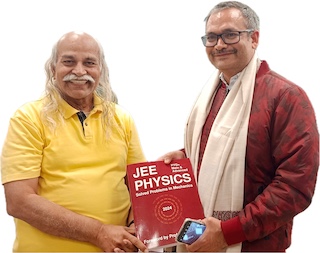Superposition of Waves
When two (or more) waves travelling through the same medium at the same time meet, the net displacement of the medium is the sum of the individual wave displacements. The waves pass through each other without being disturbed.
Constructive and Destructive Interference
Let two waves of the same frequency ($\omega$), amplitudes ($A_1$ and $A_2$), and a constant phase difference ($\delta$) are travelling in the same direction.
\begin{align} y_1 & =A_1\sin(kx-\omega t),\\ y_2 & =A_2\sin(kx-\omega t+\delta) \end{align}The displacement of the superposed wave is given by
\begin{align} y &=y_1+y_2=A\sin(kx-\omega t+\epsilon)\nonumber\\ A&=\sqrt{{A_1}^2+{A_2}^2+2A_1 A_2 \cos\delta}\nonumber\\ \tan\epsilon & =\frac{A_2\sin\delta}{A_1+A_2\cos\delta} \end{align}The amplitude of the superposed wave is the maximum if phase difference $\delta$ is even multiple of $\pi$. This is called constructive interference.
The amplitude of the superposed wave is the minimum when phase difference $\delta$ is odd multiple of $\pi$. This is called destructive interference.
\begin{align} \delta & =\left\{\begin{array}{ll} 2n\pi, &\text{constructive};\nonumber\\ (2n+1)\pi, & \text{destructive}.\nonumber \end{array}\right. \end{align}Standing Waves
Standing or stationary waves are produced when two waves of the same frequency travelling in opposite direction superpose with each other.
Beats
Beats are produced when two waves of slightly different frequencies superpose with each other.
Problems from IIT JEE
Problem (IIT JEE 2015): Four harmonic waves of equal frequencies and equal intensities $I_0$ have phase angles $0$, $\pi/3$, $2\pi/3$ and $\pi$. When they are superposed, the intensity of the resulting wave is $nI_0$. The value of $n$ is,
Solution: The intensity of a wave is proportional to the square of its amplitude i.e., $I_0=cA^2$, where $c$ is a constant. The amplitudes of four harmonic waves are equal as their intensities are equal. Let these waves be travelling along the $x$ direction with wave vector $k$ and angular frequency $\omega$. The resultant displacement of these waves is given by, \begin{align} y=& y_1+y_2+y_3+y_4\nonumber\\ =& A\sin(\omega t-kx+0) \\ & +A\sin(\omega t-kx+\pi/3)\nonumber\\ & +A\sin(\omega t-kx+2\pi/3) \\ &+A\sin(\omega t-kx+\pi) \nonumber\\ =& A\sin(\omega t-kx)-A\sin(\omega t-kx)\nonumber\\ & +A\sin(\omega t-kx+\pi/3) \\ & +A\sin(\omega t-kx+2\pi/3) \nonumber\\ =&2A\sin(\omega t-kx+\pi/2)\cos(\pi/6)\\ =&\sqrt{3}A \cos(\omega t-kx). \end{align} The amplitude of the resultant wave is $A_r=\sqrt{3}A$ and its intensity is $I_r=cA_r^2=3cA^2=3I_0$.
Note that $y_1$ and $y_4$ are out of phase and interfere destructively. The displacement $y_2$ and $y_3$ have a phase difference of $\delta=\pi/3$. Thus, we can arrive at the resultant intensity by using the formula, \begin{align} I_r &=I_0+I_0+2\sqrt{I_0}\sqrt{I_0}\cos\delta \\ &=2I_0+2I_0\cos (\pi/3) \\ &=3I_0. \end{align}
Problem (IIT JEE 1992): The displacement $y$ of a particle executing periodic motion is given by \begin{align} y=4\cos^2\left(t/2\right)\sin(1000t). \end{align} This expression may be considered to be a result of the superposition of _____ independent harmonic motions.
- two
- three
- four
- five
Solution: Given displacement can be written as, \begin{align} y&=4\cos^2(t/2)\sin(1000t) \\ &=2(1+\cos t)\sin(1000t)\nonumber\\ &=2\sin(1000t)+2\sin(1000t)\cos(t)\nonumber\\ &=2\sin(1000t)+\sin(999t)+\sin(1001t).\nonumber \end{align} Thus, $y$ is a superposition of three independent harmonic motions of angular frequencies ${999}\;\mathrm{rad/s}$, ${1000}\;\mathrm{rad/s}$,, and ${1001}\;\mathrm{rad/s}$,.
